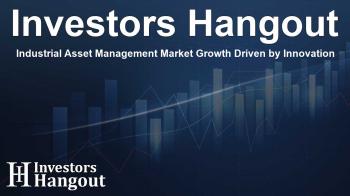Industrial Asset Management Market Growth Driven by Innovation

Understanding the Industrial Asset Management Market Growth
The Industrial Asset Management (IAM) market is on the verge of significant expansion, with expectations to skyrocket to USD 654.30 billion by 2032, starting from USD 156.36 billion in 2023. This meteoric rise translates to a compound annual growth rate (CAGR) of 17.29% over the forecast period from 2024 to 2032. Such growth is primarily fueled by the surging need for predictive maintenance, coupled with advances in IoT that are optimizing asset management practices across industries.
Market Dynamics and Growth Drivers
The drive behind this market surge is deeply rooted in the rapid digital transformation that many businesses are undertaking. Companies are increasingly seeking ways to enhance operational efficiencies and reduce downtime, all of which are crucial in the competitive landscape of industrial operations. Predictive maintenance is becoming a cornerstone of asset management, allowing organizations to address issues before they result in significant costs and disrupted operations.
The Role of IoT in Asset Optimization
As Internet of Things (IoT) technology continues to integrate into manufacturing and operational frameworks, the capabilities of asset tracking and management are enhanced tremendously. IoT facilitates real-time data collection from assets, which leads to better decision-making and resource allocation. This technology allows for unprecedented visibility into asset health, performance metrics, and the identification of potential issues long before they happen.
Sector Analysis: Services vs Software
Breaking down the IAM market by segment, services capture a significant portion, comprising nearly 40% of revenue in 2023. Consulting, implementation services, and ongoing support are pivotal as firms transition away from outdated systems. Meanwhile, the software sector is projected to experience the fastest growth rate. Cloud integration, AI-driven analytics, and mobile asset management are enticing more small and medium enterprises to adopt innovative solutions, driving this segment forward.
Asset Types and Market Segmentation
When analyzing asset types, manufacturing assets lead the market share due to extensive implementation of asset monitoring systems in operational environments. Smart sensors and advanced diagnostic technologies are essential for reducing unplanned downtimes, thus saving organizations from costly interruptions. Additionally, the returnable transport assets segment is expected to witness the highest growth rate, driven by evolving logistics needs and supply chain complexities.
Regional Insights: North America vs. Asia-Pacific
Geographically, North America has historically dominated the IAM market, thanks to its early adoption of advanced technologies and significant industrial automation investments. Major enterprises in the U.S. routinely focus on optimizing performance across various sectors, particularly in manufacturing and energy.
Conversely, the Asia-Pacific region is on track for substantial growth in the coming years, spurred by its ongoing industrialization, investments in smart manufacturing capabilities, and supportive governmental initiatives aimed at advancing digital transformation efforts within industries.
Recent Innovations Shaping the Future
Noteworthy advancements made by key players in the IAM market are setting the stage for enhanced functionality and user experience. Innovations from leading companies like ABB, who unveiled their Ability Genix APM Suite, highlight the shift towards AI-powered asset management solutions that drive efficiency and insight. Similarly, collaborations such as that between Schneider Electric and Aveva are enhancing asset management frameworks across various industrial sectors.
As organizations race to modernize their operations, the versatility of the IAM market underscores its significance in achieving business goals centered around efficiency and reliability. The increasing penetration of AI, along with strategic partnerships and technological advancements, indicates a promising growth trajectory.
Frequently Asked Questions
What is the projected market value of Industrial Asset Management by 2032?
The Industrial Asset Management market is projected to reach USD 654.30 billion by 2032.
What factors are driving growth in this sector?
Key drivers include the demand for predictive maintenance and the integration of IoT technologies for better asset optimization.
Which segment holds the largest market share?
In 2023, the services segment accounted for 40% of the market share, indicating a high demand for consulting and support.
What geographical region is leading the IAM market?
North America is currently the leading region in the IAM market due to its early technology adoption and robust investment in industrial automation.
How is the role of software evolving in this market?
The software segment is expected to grow the fastest as businesses increasingly adopt cloud integration and AI-driven analytics solutions.
About The Author
Contact Dylan Bailey privately here. Or send an email with ATTN: Dylan Bailey as the subject to contact@investorshangout.com.
About Investors Hangout
Investors Hangout is a leading online stock forum for financial discussion and learning, offering a wide range of free tools and resources. It draws in traders of all levels, who exchange market knowledge, investigate trading tactics, and keep an eye on industry developments in real time. Featuring financial articles, stock message boards, quotes, charts, company profiles, and live news updates. Through cooperative learning and a wealth of informational resources, it helps users from novices creating their first portfolios to experts honing their techniques. Join Investors Hangout today: https://investorshangout.com/
The content of this article is based on factual, publicly available information and does not represent legal, financial, or investment advice. Investors Hangout does not offer financial advice, and the author is not a licensed financial advisor. Consult a qualified advisor before making any financial or investment decisions based on this article. This article should not be considered advice to purchase, sell, or hold any securities or other investments. If any of the material provided here is inaccurate, please contact us for corrections.

